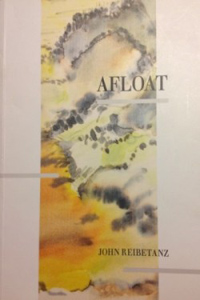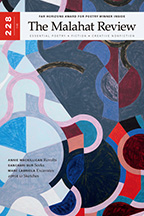Reviews
Poetry Review by Mitchell Parry
John Reibetanz, Afloat (London: Brick, 2013). Paperbound, 87 pp., $20.
As a child, I learned in school that human beings are mostly made of water. This was hard to believe: after all, if we were mostly water, why didn’t we make sloshing noises when we walked? Although he doesn’t answer that question, in his eighth collection, Toronto-based poet John Reibetanz does tackle the larger issue of our relationship to water in its many forms. The complexity of this relationship becomes apparent in the collection’s opening poem, “The Love of Water,” which asserts,
All nature, from the crag windbreakered in granite
that melts into the nuzzling of the clouds’ wet snouts,
to the motes of grit that rise up every morning
and dance in a fountain over the windowsill,
all nature wants to be water.
The desire to “be water” runs throughout the book’s three sections, perhaps finding its clearest articulation early in the collection in “Water and Clay.” Initially, the two elements (earth and water) are “A marriage doomed to failure,” but by the end of the poem they find a kind of resolution in the form of a clay teapot—“purple clay (which is what we all / are), shaped to hold warm water (which is what / we all are).” The creation of the pot crafts a “miracle // coupling of all four elements” that ultimately makes of the reader an “Arbour where / water and clay within you sip from clay / and water and renew their wedding vows.” The transformative power of art—here, pottery, but also, clearly, poetry—makes possible the renewal of this marriage of the elements, at the same time implying a cyclical pattern of “failure” and rejuvenation.
Reibetanz deftly avoids the standard English-class cliché that “water is life,” instead concentrating on the roles it plays in human actions and human being. As a result, he finds evidence of the ubiquity of water in unusual, sometimes disarming situations. In “Floater,” for example, he writes about what appears to be a detached retina: “Now every place the eyelid / lifts its shade, the same shred of wreckage / washes up on the landscape.” The poem’s description of “a phantom inkspot,” of “a dark new / moon in erratic orbit,” brilliantly captures that sensation we all experience when watching “floaters,” those tiny specks that wash across our field of vision. Reibetanz reminds us that “we’re all floaters” on the earth, and that “what we see is one / with where we are.” Appropriately, the poem concludes by emphasizing the “buoyancy” of being in the world.
That buoyancy is abandoned in the collection’s second section, “Laments of the Gorges.” This extended meditation focuses on China’s Three Gorges Dam project and the consequences of industrial disruption of the flow of water; significantly, however, Reibetanz contrasts industry’s environmental abuse with the products of human art. Beginning with tenth-century painter Dong Yuan’s “Riverbank” scroll, the section guides us through time until we arrive at the present day in the form of the incredible (and, often, incredibly disheartening) photography of Edward Burtynsky. In the final poem of the sequence, “Reclamation: The Concert,” the speaker again finds solace in the “ginger-sweet music” of art.
In his endnotes, Reibetanz claims that throughout the collection he has attempted to emulate formal elements of Chinese poetry—particularly through the absence of punctuation. This formal experimentation really comes into its own in the “Laments of the Gorges” section. As they are in “Displacement,” the results are often quite striking:
Sometimes her eyes lidded in afternoon sun the skin
of her hands butterfly-wing-thin paper watermarked
by streaming clouds she opens and closes the conjoined
red paper-cut fish as if each half were the slowly
clasping and unclasping wing of a perched butterfly
Two things happen here: the lack of punctuation emphasizes the poet’s laser-eyed attention to detail, precisely placing each image before the reader; more significantly, the accumulation of image upon image reflects the slow-swirling eddies of the river itself. Images flow, pool and collect—at times, almost suffocatingly. That Reibetanz is able to rein in the poems at the precise moment is testament to his skills as a poet.
The final section of the book, “Airborne,” is, literally, like a breath of fresh air after the narrowed focus of “Laments of the Gorges.” Reibetanz allows himself to play with form and references (Virgil, Paul Celan, George Herbert). Though less clearly linked to the book’s watery theme, this last grouping of poems leaps and bubbles like a fountain.
In all honesty, this is not a collection one can simply dip into and read in an afternoon. The poems weave together in complex—though always intriguing—ways. In places, the weight of the imagery borders on excessive density, and yet Reibetanz repeatedly capitalizes on that density, encouraging the reader to actively engage with the poems. This is an excellent and complex collection that repays revisits. One last note: kudos to Brick Books, and particularly to designer Cheryl Dipede, for the book’s stunningly effective design.
—Mitchell Parry









